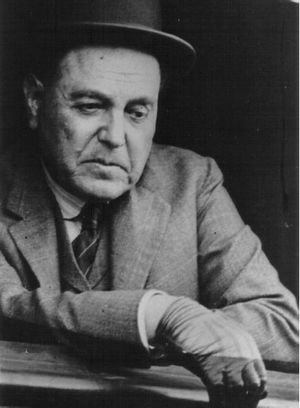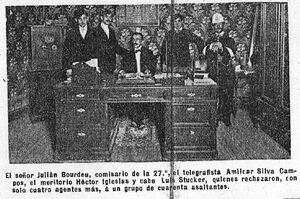هيپوليتو إريگوين
| هيپوليتو إريگوين Hipólito Yrigoyen | |
|---|---|

| |
| رئيس الأرجنتين | |
| في المنصب 12 أكتوبر 1928 – 6 سبتمبر 1930 | |
| نائب الرئيس | Enrique Martínez |
| سبقه | Marcelo T. de Alvear |
| خلفه | José Félix Uriburu |
| في المنصب 12 أكتوبر 1916 – 11 أكتوبر 1922 | |
| نائب الرئيس | پلاجيو لونا |
| سبقه | ڤيكتوريانو دلا پلازا |
| خلفه | Marcelo T. de Alvear |
| تفاصيل شخصية | |
| وُلِد | 12 يوليو 1852 بوينس آيرس، الأرجنتين |
| توفي | 3 يوليو 1933 (عن عمر 80) بوينس آيرس، الأرجنتين |
| الحزب | الاتحاد المدني الراديكالي |
| المهنة | محامي ومدرس |
| التوقيع | 
|
خوان هيپوليتو دل ساگرادو كورازون دى خسوس إريگوين (Juan Hipólito del Sagrado Corazón de Jesús Yrigoyen ؛ النطق الإسپاني: [i'polito iri'ɣoʝen]؛ 12 يوليو 1852 – 3 يوليو 1933) كان سياسياً أرجنتينياً في الاتحاد المدني الراديكالي ورئيس الأرجنتين مرتين، أولاهما من 1916 إلى 1922 والفترة الثانية من 1928 إلى 1930. كان أول رئيس يُنتخَب ديمقراطياً بالاقتراع السري الإجباري لكل الذكور الذين حصلوا على حق الانتخاب من قانون ساينز پنيا في 1912. نشاطه السياسي كان الدافع لتمرير ذلك القانون في الأرجنتين.
يُعرَف بلقب "أبو الفقراء"، فقد شهدت رئاسته ارتفاعاً مستوى معيشة الطبقة العاملة في الأرجنتين مع تمرير عدد من الإصلاحات الاجتماعية التقدمية، منها تحسنات في ظروف المصانع وتنظيم ساعات العمل والمعاشات الإجبارية ووضع نظام تعليمي متاح للجميع.
كان إريگوين أول رئيس nationalist، convinced that the country had to manage its own currency and, above all, it should have control of its transportation and its energy and oil exploitation networks.[1]
Between the 1916 general election and the September Revolution, political polarization was on the rise. Personalist radicalism was presented as the "authentic expression of the nation and the people" against the "oligarchic and conservative regime". For the ruling party, the will of the majorities prevailed over the division of powers. The opposition, on the other hand, accused the Executive Branch of being arrogant and demanded greater participation from Congress, especially in matters such as the conflictive federal interventions.[2]
التمرد المسلح
ثورة 1905
There were several signs in early February 1905 that a new radical revolution was coming, and in late January, the revolutionaries left for their destinations throughout the country to begin their revolt. However, both the government and the police suspected that there were planas of a conspiracy against them and so they broke into several buildings and arrested civilians who resorted to their weapons. Alarmed, General Smith, the Army Chief of Staff, headed to the armory to fortify his unit and defend the city's arsenal. Thirty-three unarmed revolutionaries entered at 4 a.m. and were arrested when they asked for Martín Yrigoyen. The revolutionaries' failure to capture the arsenal reduced hope for the revolution, as the plan had been to arm civilians with weapons from the arsenal.[3]
الحياة اللاحقة
بعد الإطاحة به، وُضِع إريگوين قيد الحبس المنزلي واِعتُقِل عدة مرات إلى جزيرة مارتن گارسيا. وقد توفي في بوينس آيرس في 1933 ودُفِن في مقبرة لا ركولتا.[بحاجة لمصدر]
المراجع
- ^ "Características de Presidencia de Hipólito Yrigoyen (1916-1922)".
- ^ Perochena, Camila (4 July 2021). "Presidentes en la tormenta. Yrigoyen, acosado por la violencia y la crisis política". La Nación.
- ^ Luna, 1986, p. 134.
ببليوگرافيا
- Amuchástegui, Antonio (1972). Mentalidades argentinas 1860–1930. Editorial Universitaria de Buenos Aires.
- Herrera de Noble, Ernestina (2010). Hipólito Yrigoyen. Grandes biografías de los 200 años. Buenos Aires: Sol 90. ISBN 978-987-07-0844-5..
- Herrera de Noble, Ernestina (dir.) (2011a). Diario Clarín (ed.). Yrigoyen gana con la nueva ley 1916. Historia de las elecciones argentinas. Vol. 3. Buenos Aires: Artes Gráficas Rioplatenses. ISBN 978-987-07-1392-0. (Series ISBN 978-987-07-1389-0)
- Luna, Félix (1986). Yrigoyen. Hyspamerica. ISBN 950-614-361-7.
- Luna, Félix (1999). Alvear. Editorial Sudamericana. ISBN 950-07-1522-8.
وصلات خارجية
 Media related to هيپوليتو إريگوين at Wikimedia Commons
Media related to هيپوليتو إريگوين at Wikimedia Commons- Newspaper clippings about هيپوليتو إريگوين in the 20th Century Press Archives of the ZBW
| مناصب سياسية | ||
|---|---|---|
| سبقه ڤيكتوريانو دلا پلازا |
رئيس الأرجنتين 1916–1922 |
تبعه Marcelo T. de Alvear |
| سبقه Marcelo T. de Alvear |
رئيس الأرجنتين 1928–1930 |
تبعه José Félix Uriburu |
- Short description is different from Wikidata
- Articles with hatnote templates targeting a nonexistent page
- مقالات ذات عبارات بحاجة لمصادر
- رؤساء الأرجنتين
- نشطاء أرجنتينيون
- مواليد 1852
- وفيات 1933
- سياسيو الاتحاد المدني الراديكالي
- زعماء أطاحت بهم انقلابات
- سياسيون من بوينس آيرس
- أرجنتينيون من أصل باسكي
- أرجنتينيون من أصل گاليسي
- بناؤون أحرار أرجنتينيون
- خريجو جامعة بوينس آيرس
- Burials at La Recoleta Cemetery
- سياسيون أرجنتينيون في القرن العشرين
- Collars of the Order of Isabella the Catholic


